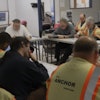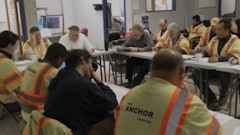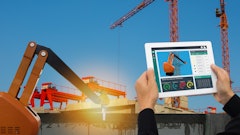
Construction costs in North America rose for the 25th straight month in February, this time marked by a prominent gain in the cost of wages tied to the continuing demand for shale gas and tight oil, especially in gas- and oil-related work centering around the U.S. Gulf Coast, according to IHS and the Procurement Executives Group (PEG).
The headline current IHS PEG Engineering and Construction Cost Index (ECCI) registered 55.9 percent in February, up 1.8 percentage points from January. Both the ECCI’s subcomponents -- the materials/equipment index and the subcontractor labor index -- also moved higher during the period, painting a consistent picture of stronger prices on the two fronts.
In particular, the subcontractor labor component of the ECCI is up in February to 57.6 percent, compared to 53.8 percent a month earlier, as presented in the attached figure. The nearly 4 point gain is the highest in seven months since the 6.6 point increase in July 2013, when the mark had reached 59.6 percent.
“The strengthening picture of labor costs was broad-based across both regional and occupational cross sections,” said Laura Hodges, director of the Pricing and Purchasing Service at IHS. “Specifically, the U.S. South continues to post the highest index level of any region given the energy boom and demand for labor in the area, which has lifted wage costs relative to other regions in North America.” The Gulf Coast is host to the production boom of shale gas and tight oil in the United States.
The scale of the increase does not necessarily mean that prices rose at a higher rate. However, it does mean that more survey respondents reported rising labor costs, indicating a broader-based hike in labor costs throughout the North American construction industry. The rise in costs ranged across all three labor categories spanning the civil, mechanical and instrumentation, and electrical fields.
Meanwhile, the materials/equipment component of the ECCI also rose in February. The index reached 55.2 percent in February, up from 54.2 percent in January and 51.4 percent in December, and is now at its highest mark since March 2013.
Similar to January, 10 of the 12 subcomponents in the materials/equipment index showed higher prices in February, with freight rates as the only subcategory still showing falling prices. And while notable pockets of strength were concentrated across the carbon and alloy steel pipe markets, copper-based wire and cable appeared to be registering the weakest monthly move in February after recording the highest index level in nearly a year in January.
“While copper markets have exhibited some tightness since December, worries about emerging market growth, and specifically conditions in China, triggered a price correction on the London Metal Exchange beginning in late January that appears to have quickly cascaded downstream,” said John Mothersole, research director of the Pricing and Purchasing Service at IHS. In all, the copper-based wire and cable index has historically shown the most variability from month to month, Mothersole pointed out.
For the six-month headline expectation, the overall index is posting at 65.9 percent in February, up from 53.8 percent last month, with both the materials/equipment and subcontractor labor portions climbing during the month.
By definition as a diffusion index, the rise in the materials/equipment component of the ECCI does not necessarily indicate that prices are strengthening in February, but rather that more survey respondents are experiencing higher prices in the North American construction i



















